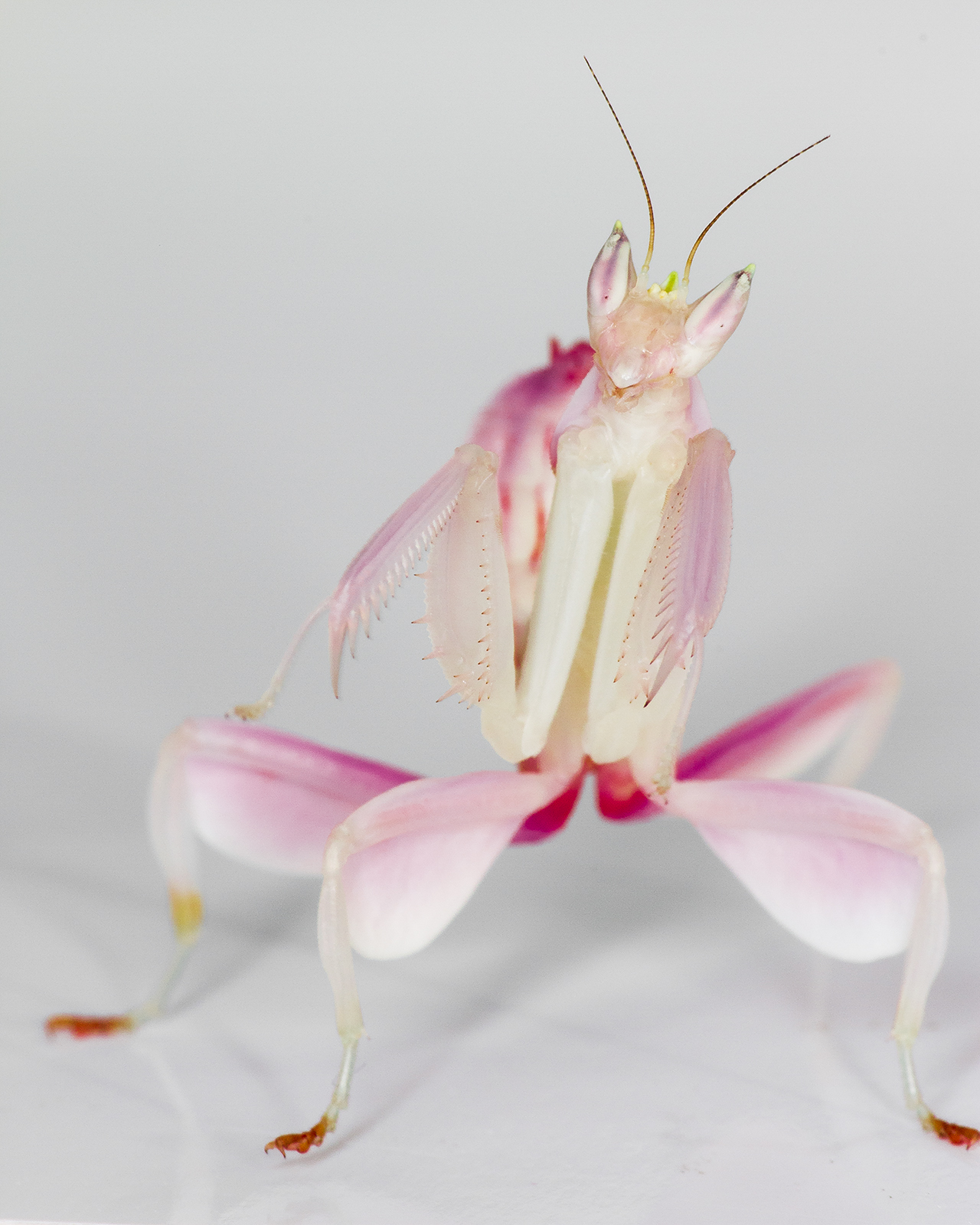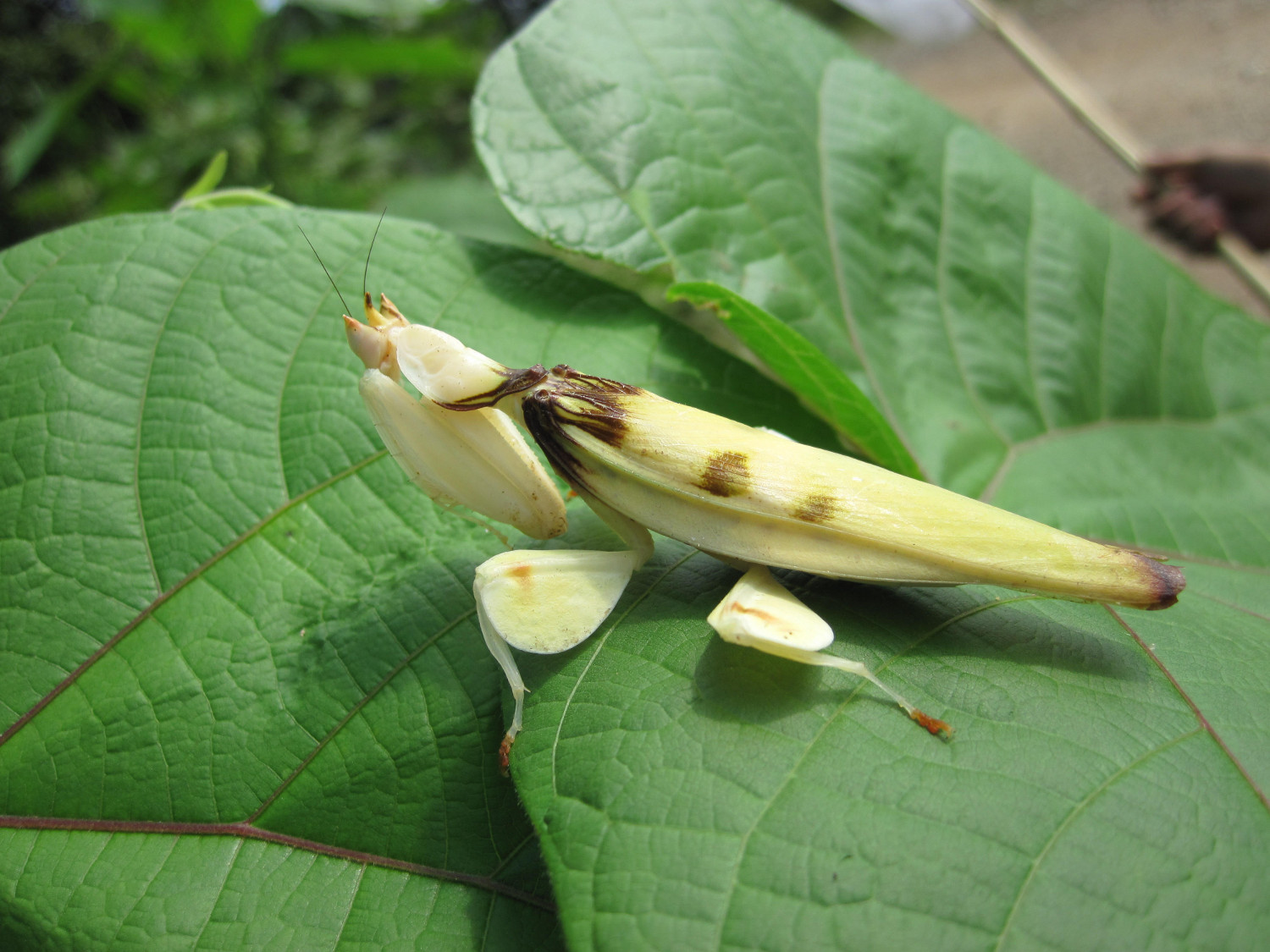Unraveling The Orchid Mantis Mystery
This elusive praying mantis lures insect prey by exploiting flower-like attributes.

A female juvenile orchid mantis (Hymenopus coronatus). Photo courtesy of James O'Hanlon
Orchid mantises—particularly juveniles—seem aptly named. They’re predominantly white with pink or yellow accents, similar to some orchids and other flowers, and their four hind legs are lobed, like petals. But if you search for an exact floral counterpart, as behavioral ecologist James O’Hanlon did, you probably won’t find one. “I spent forever looking for a flower that they look just like,” he says, to no avail.
As it turns out, rather than mimicking one floral species, the insect instead may embody a “generic or an average type of flower” in order to attract bees and other pollinating insects as prey.
What’s more, as far as O’Hanlon can tell, it’s the only animal on record that “takes on the guise of a whole flower blossom” as a predatory strategy, he wrote in a brief orchid mantis guide, appearing this past February in Current Biology. (As mantises mature, they appear—at least to humans—less like flowers, because their long wings extend over the thorax and abdomen, covering their legs).

An elusive species of praying mantis, the orchid mantis (Hymenopus coronatus) stalks the rainforests of Southeast Asia and Indonesia in characteristic solitude (mantises are generally loners). The insect first beguiled O’Hanlon, a postdoctoral fellow at Macquarie University in Sydney, Australia, several years ago, when he was researching another species in the mantid literature and came across this “amazing-sounding, almost like a mythical beast sort of creature,” he says. After digging for more details and coming up short, he realized that “nobody had ever [experimentally] studied it, so I decided that it’s about time someone did.”
Over the course of several years, as part of his Ph.D. work, O’Hanlon fleshed out the orchid mantis profile in a handful of published studies. “I think the most surprising finding is just seeing how good they actually are at attracting pollinators,” he says. “The very first study we published on them actually showed that they attracted more bees than other flowers in their environment.”
At least part of the mantis’s success seems to be its ability to exploit how pollinators respond to color. Using a mathematical modeling system that represents how certain insects perceive the world around them, O’Hanlon and colleagues calculated how—from the perspective of representative prey species—the coloring of juvenile orchid mantises compares to the hues of more than a dozen flower species found in mantis habitat in the Malaysian peninsula. They found that the mantis’s color fits within the spectrum of floral shades tested but had no identical match, suggesting that when would-be pollinators see an orchid mantis, they detect a color that signifies a generic sense of “flower.”

O’Hanlon’s team also compared the morphology of juvenile orchid mantis abdomens and leg lobes to the petals of flowers found in Malaysian orchid mantis habitat. Again, they found no floral matches but enough commonality to suggest that the insect’s body fits a blossom-like mold.
The lobed appendages, however, don’t seem to influence how attractive the orchid mantis is to prey—another finding that surprised O’Hanlon. Indeed, in one field experiment, he removed or rearranged the leg lobes of model mantises, yet pollinators still flew in for inspection. Reporting in the journal Ethology in 2014, O’Hanlon suggested that rather than serving an attractive function, the petal-like legs could potentially act as camouflage to help the insect avoid predators of its own.
In his Current Biology guide, O’Hanlon concludes that there’s “no compelling evidence to suggest that orchid mantises mimic a specific orchid, or any other specific flower.” Instead, “they may simply present a generalized ‘flower-like’ stimulus” that is able to “tap into innate sensory biases of pollinators.” (Some flowers rely on similar deceptive strategies.)
O’Hanlon rationalizes his conclusion this way: “If you’re a flower, you’re [often] interested in attracting a specific pollinator, because you want that pollinator to be visiting other flowers of the same type to transfer your pollen. If you’re a mantis, you don’t really want a specific type of insect—you just want something that you can eat.” In short, hungry mantises can’t be picky eaters.

In other work, O’Hanlon and colleagues also found that, unlike certain predators that hide among flowers in an attempt to ambush prey, orchid mantises are content hanging out in plain view. But their research also suggests that the insects have better luck when they situate themselves in flower-rich areas, where more pollinators are likely to buzz about. “The more flowers you have near the orchid mantis, the more bees that they’re gonna be attacking and trying to eat,” says O’Hanlon.
Martin Stevens, an associate professor in sensory and evolutionary ecology at the University of Exeter, whose new book, Cheats and Deceits, includes a section on the orchid mantis, has found O’Hanlon’s work informative. But he suspects that the insect’s predatory success depends on more than its attractive hue. “[Pollinators] might be initially lured to it by the bright colors,” he says, but there’s still a chance that prey are “mistaking it when they’re close for a [whole] flower.”
In a study published in Current Zoology in 2014, O’Hanlon acknowledged that other unknown factors, such as behavior and olfaction, might influence how pollinators are drawn to orchid mantises. But he leaves any future investigations to the next person who comes under the insects’ spell. “They’re really quite docile,” he says, “they’ll just sort of crawl along your hand.”

*Per audience request, the photo above of an adult female orchid mantis was added on April 18, 2016.
Julie Leibach is a freelance science journalist and the former managing editor of online content for Science Friday.